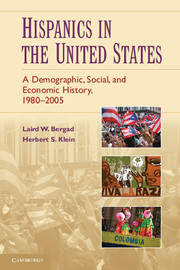Book contents
- Frontmatter
- Contents
- List of Graphs, Tables, and Maps
- Introduction
- 1 Immigration to the United States to 1980
- 2 The Hispanic Population to 1980
- 3 Population Growth and Dispersion, 1980–2005
- 4 The Demography of the Hispanic Population
- 5 Wealth and Poverty
- 6 Educational Attainment
- 7 Citizenship, the Latino Electorate, and Voter Participation
- 8 Occupational Structures, Employment, and Unemployment
- 9 English Language Abilities and Domestic Usage
- 10 Hispanic Business Ownership
- 11 Race
- 12 Endogamous and Exogamous Marriage Patterns among Latino Household Heads
- 13 Conclusion
- Bibliography
- Index
- References
5 - Wealth and Poverty
Published online by Cambridge University Press: 05 June 2012
- Frontmatter
- Contents
- List of Graphs, Tables, and Maps
- Introduction
- 1 Immigration to the United States to 1980
- 2 The Hispanic Population to 1980
- 3 Population Growth and Dispersion, 1980–2005
- 4 The Demography of the Hispanic Population
- 5 Wealth and Poverty
- 6 Educational Attainment
- 7 Citizenship, the Latino Electorate, and Voter Participation
- 8 Occupational Structures, Employment, and Unemployment
- 9 English Language Abilities and Domestic Usage
- 10 Hispanic Business Ownership
- 11 Race
- 12 Endogamous and Exogamous Marriage Patterns among Latino Household Heads
- 13 Conclusion
- Bibliography
- Index
- References
Summary
There has been a long debate in the academic literature about the relative skill levels of Latino immigrants, their wages compared to domestic-born workers, and whether or not they have depressed salaries for unskilled and semiskilled laborers, particularly African Americans. There has also been considerable discussion about whether there has been economic and social mobility within Latino communities, especially for second- and third-generation children of Mexican and other immigrants. Some have assumed that part of the story of Latin American and Caribbean immigration is economic stagnation and low levels of social mobility over time. Others have argued that the experiences of Latino populations are unique and that they are unlike previous waves of migrants and their descendants in the United States in terms of integration or acculturation levels into the dominant society.
An unfortunate and inaccurate image of enduring poverty has emerged and this has obfuscated the fact that from a historical perspective the Latino population of the United States is very much like every racial and ethnic group with respect to social and economic stratification, as well as mobility. Additionally, there are extraordinary similarities when Hispanics are compared with prior waves of migration to the United States in the 19th and 20th centuries. The large-scale arrival of immigrants from Latin America and the Caribbean after 1980, many of them coming from impoverished rural environments, has surely exacerbated the problem of poverty within Latino communities. Yet, a solid and growing Latino middle class has emerged and high-income-earning individuals, families, and households exist within each national group and in every major region of Hispanic population concentration. An examination of income data since 1980 reveals the difficulty of making sweeping and often impressionistic generalizations about Latino economic performance.
- Type
- Chapter
- Information
- Hispanics in the United StatesA Demographic, Social, and Economic History, 1980–2005, pp. 123 - 191Publisher: Cambridge University PressPrint publication year: 2010



